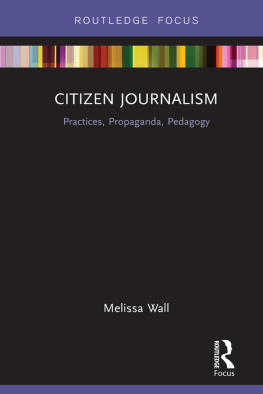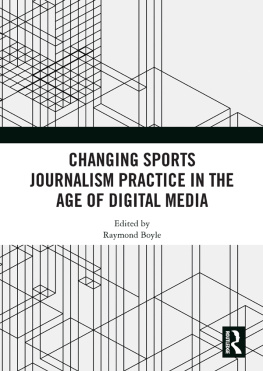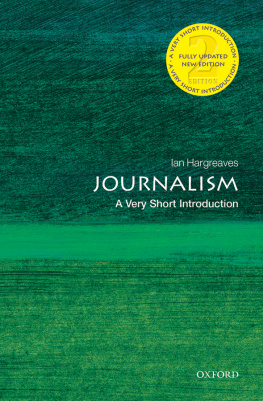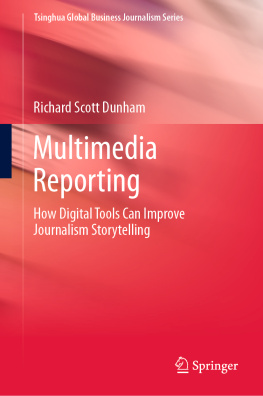HISTORICAL DICTIONARIES OF
PROFESSIONS AND INDUSTRIES
Jon Woronoff, Series Editor
1. Japanese Business, by Stuart D. B. Picken, 2007.
2. Fashion Industry, by Francesca Sterlacci and Joanne Arbuckle, 2008.
3. Petroleum Industry, by M. S. Vassiliou, 2009.
4. Journalism, by Ross Eaman, 2009.
Historical Dictionary of Journalism
Ross Eaman
Historical Dictionaries of
Professions and Industries, No. 4

SCARECROW PRESS, INC.
Published in the United States of America
by Scarecrow Press, Inc.
A wholly owned subsidiary of
The Rowman & Littlefield Publishing Group, Inc.
4501 Forbes Boulevard, Suite 200, Lanham, Maryland 20706
www.scarecrowpress.com
Estover Road
Plymouth PL6 7PY
United Kingdom
Copyright 2009 by Ross Eaman
All rights reserved. No part of this publication may be reproduced, stored in a retrieval system, or transmitted in any form or by any means, electronic, mechanical, photocopying, recording, or otherwise, without the prior permission of the publisher.
British Library Cataloguing in Publication Information Available
Library of Congress Cataloging-in-Publication Data
Eaman, Ross Allan, 1945
Historical dictionary of journalism / Ross Eaman.
p. cm. (Historical dictionaries of professions and industries)
Includes bibliographical references.
ISBN-13: 978-0-8108-6075-9 (cloth : alk. paper)
ISBN-10: 0-8108-6075-9 (cloth : alk. paper)
ISBN-13: 978-0-8108-6289-0 (ebook)
ISBN-10: 0-8108-6289-1 (ebook)
1. JournalismHistoryDictionaries. I. Title.
PN4728.E37 2009 |
070.9dc22 | 2008037829 |
 The paper used in this publication meets the minimum requirements of American National Standard for Information SciencesPermanence of Paper for Printed Library Materials, ANSI/NISO Z39.48-1992.
The paper used in this publication meets the minimum requirements of American National Standard for Information SciencesPermanence of Paper for Printed Library Materials, ANSI/NISO Z39.48-1992.
Manufactured in the United States of America.
Contents
Jon Woronoff
Editors Foreword
Journalism, more than most other professions, is often seen as a higher calling, since journalists are expected to dig up the facts, assemble them logically, and then present them cogently in order to provide the knowledge so other people can make good choices in their lives. There are lazy and incompetent journalistsand editorsand others who just want to promote their own views; but on the whole, journalists have been crucial over the past several centuries and will probably remain so well into the future, even if their work assumes new forms. Journalism is also an industry, since it costs money to produce newspapers, newsletters, and even blogs, so financial concerns enter the picture and muddy the waters. While there have been some very enlightened, progressive, and even fearlessly crusading newspapers, there have also been many of lesser value, more interested in just providing entertainment or turning a profit.
This Historical Dictionary of Journalism shows both sides of the picture. The dictionary presents entries on some of the finest newspapers as well as those of lesser repute, many exceptional journalists as well as others the profession would rather forget, major advances such as investigative reporting and more questionable practices such as yellow journalism, and important topics like censorship and the continuing struggle for freedom of the press. It covers a long period of time, from the very first practitioners whose news was often sung to the most recent whose news appears in a computerized format. Last but not least, it traces the history of journalism in a large number of countries in a lengthy chronology and then an introduction, which analyzes individual developments thematically, showing how the discursive practices of journalism have evolved within a larger political, economic, and cultural context. Despite the breadth of coverage, the field of journalism history is so large that any work of this kind can constitute only a starting point for further research and study, so the substantial bibliography organizes recent literature in the field to facilitate this task.
This new addition to the Historical Dictionaries of Professions and Industries series was written by Ross Eaman, who has been a full-time member of faculty in the School of Journalism and Communication at Carleton University in Canada since 1980. His earlier publications include The Media Society: Basic Issues and Controversies (1987) and Channels of Influence: CBC Audience Research and the Canadian Public (1994). This volume builds on his interest in communication and democracy and the role of public broadcasting, but it reaches further, covering the lengthy history of journalism within a global context. It also provides the wide variety of topics, issues, and considerations related to understanding journalism as an industry and profession.
Jon Woronoff
Series Editor
Preface
The story of journalism is first and most visibly a tale of changing media, from ballads and chronicles to newsletters and newsbooks, newspapers and magazines, and eventually newscasts and websites. But this story begins to come alive only when the focus shifts to the texts conveyed through those media and the way these have evolved as a form of discourse over the past five centuries. Most of the components of this discoursethe news report, the editorial, the column, the feuilleton, the interview, the photograph, the inverted pyramid, the news lead, the bylineare familiar enough to us. But when, how, and why these components first emerged as a product of culture is more complex than we might imagine. In most cases, their genesis is tied to a cast of characters who generally nurtured and shaped rather than invented them. Some of these figures are well known: Daniel Defoe, Joseph Addison, Benjamin Franklin, James Gordon Bennett, Joseph Pulitzer, William T. Stead, Walter Lippmann, Henry Luce, and Edward R. Murrow. But many others are largely unknown: from Pietro Aretino, John Wolfe, Ben Jonson, and John Crouch in the 16th and 17th centuries to William Memory Woodfall, Francis Jeffrey, Faddej Bulgarin, Liang Qichao, Walter Williams, and Lillian Ross in the 18th, 19th, and 20th centuries. In several cases, these pioneers were the owners or producers of a journalistic enterprise or product. But their number also includes practicing journalists, social critics of journalism, and journalism educators. Each of these groups has had an important impact on journalism as it exists today and will continue to influence its nature in accordance with its own goals and ideals.
Acronyms and Abbreviations
ABC | American Broadcasting Company |
AEJMC | Association for Education in Journalism and Mass Communication (U.S.) |
AFP | Agence France-presse |
AIM | Accuracy in Media (U.S.) |
ANG | American Newspaper Guild |
ANPA | American Newspaper Publishers Association |
AP | Associated Press (U.S.) |
ASJMC | Association of Schools of Journalism and Mass Communication (U.S.) |
ASNE | American Society of Newspaper Editors |
Next page








 The paper used in this publication meets the minimum requirements of American National Standard for Information SciencesPermanence of Paper for Printed Library Materials, ANSI/NISO Z39.48-1992.
The paper used in this publication meets the minimum requirements of American National Standard for Information SciencesPermanence of Paper for Printed Library Materials, ANSI/NISO Z39.48-1992.